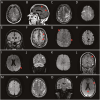Sulcal Hyperintensity as an Early Imaging Finding in Cerebral Amyloid Angiopathy-Related Inflammation
- PMID: 39586054
- PMCID: PMC11658812
- DOI: 10.1212/WNL.0000000000210084
Sulcal Hyperintensity as an Early Imaging Finding in Cerebral Amyloid Angiopathy-Related Inflammation
Abstract
Background and objectives: Cerebral amyloid angiopathy-related inflammation (CAA-ri) is a subtype of CAA with distinct clinical and radiologic features. Existing diagnostic criteria require the presence of characteristic asymmetrical white matter hyperintensity (WMH), together with classical hemorrhagic neuroimaging markers of CAA. There are limited data for other diagnostic neuroimaging markers of CAA-ri.
Methods: This is a case series from a specialist hospital intracerebral hemorrhage service.
Results: We describe 4 patients with CAA-ri who had regions of sulcal hyperintensity, with or without gyral swelling at clinical presentation, but did not fulfill current diagnostic criteria because of the absence of typical asymmetric WMH on brain MRI. All 4 patients were subsequently diagnosed with CAA-ri; three later developed asymmetric WMHs with disease relapse, and 2 had pathologically proven CAA-ri; 1 patient had both.
Discussion: Regions of sulcal hyperintensity, sometimes with associated gyral swelling, can be an early imaging finding in CAA-ri. These neuroimaging markers could potentially improve the accuracy of existing diagnostic criteria for CAA-ri to allow earlier diagnosis and treatment without biopsy in patients with atypical presentations.
Conflict of interest statement
L. Panteleienko is supported in her work at the UCL Queen Square Institute of Neurology and National Hospital for Neurology and Neurosurgery, Queen Square, by a Council for At-Risk Academics (CARA-UCL) Academic Sanctuary Fellowship. G. Banerjee is an NIHR Clinical Lecturer and additionally receives research funding from Alzheimers Research UK and the Stroke Association. M.S. Zandi receives funding from the UCL/UCLH Biomedical Research Centre, and has received honoraria for one lecture each for each of the 4 mentioned in the last 4 years: Cygnet Healthcare; UCB Pharma and GSK. Go to
Figures

References
-
- Boncoraglio GB, Piazza F, Savoiardo M, et al. . Prodromal Alzheimer's disease presenting as cerebral amyloid angiopathy-related inflammation with spontaneous amyloid-related imaging abnormalities and high cerebrospinal fluid anti-Aβ autoantibodies. J Alzheimers Dis. 2015;45(2):363-367. doi:10.3233/JAD-142376 - DOI - PubMed
Publication types
MeSH terms
LinkOut - more resources
Full Text Sources
Medical
